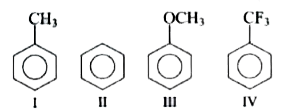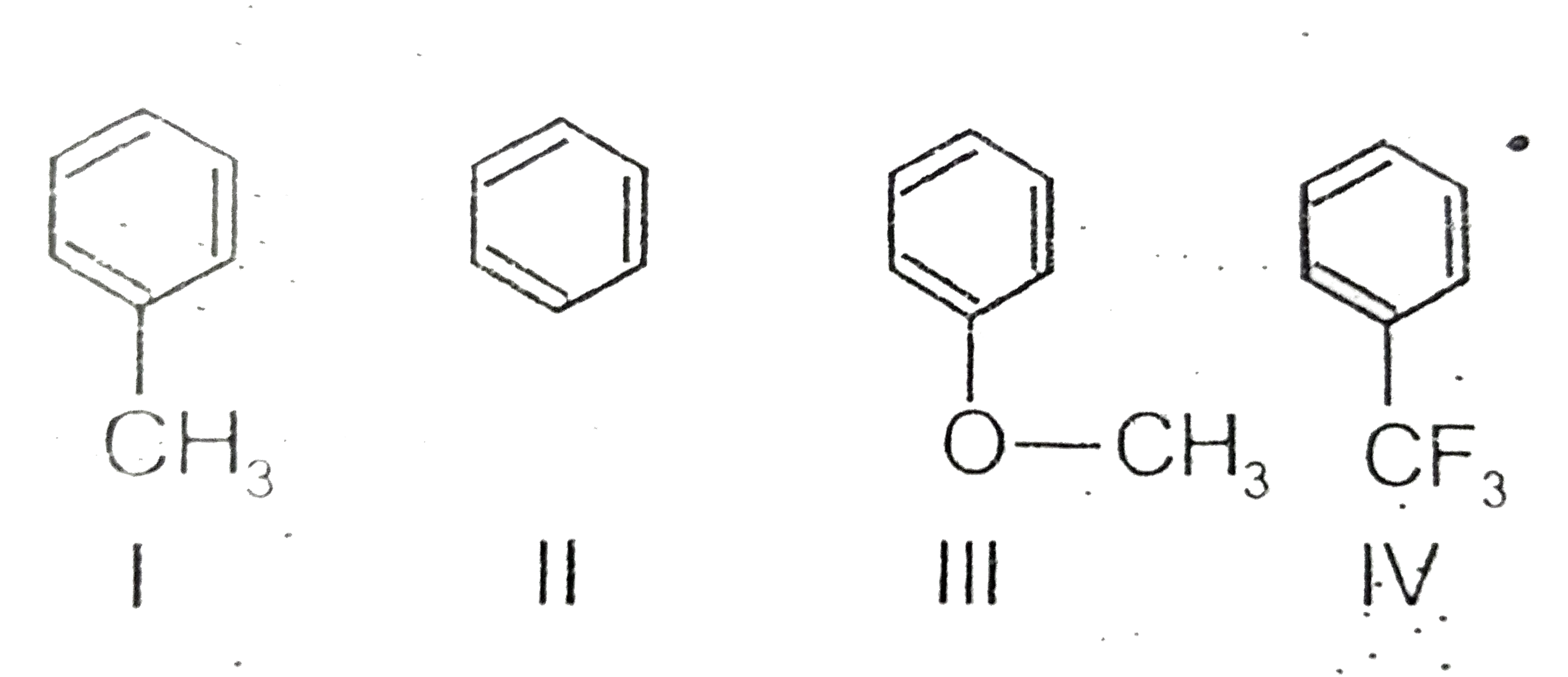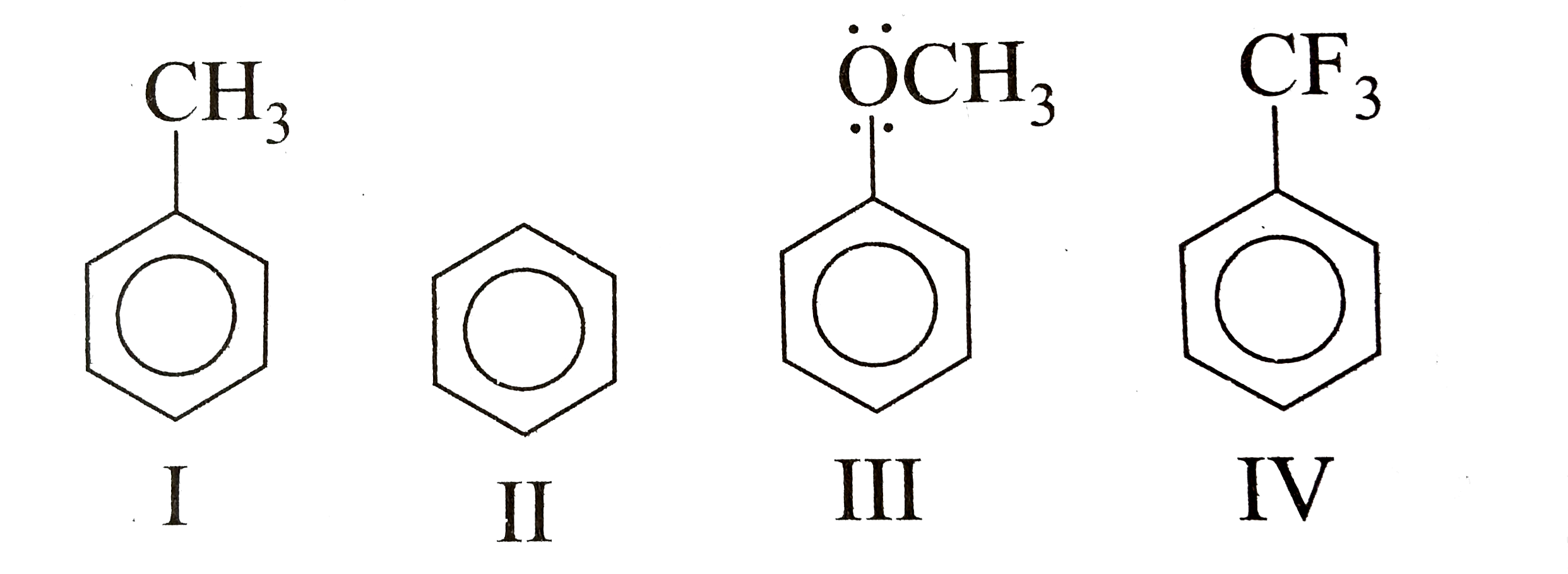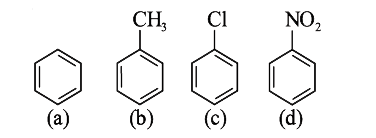The correct order of reactivity towards electrophilic substitution is
benzene > phenol > benzoic acid > chlorobenzene
phenol > benzene > chlorobenzene > benzoic acid
chlorobenzene > benzoic acid > phenol > benzene
benzoic acid > chlorobenzene > benzenegtphenol.
The correct Answer is:B
To determine the correct order of reactivity towards electrophilic substitution for the compounds benzene, phenol, benzoic acid, and chlorobenzene, we will analyze the influence of substituents on the aromatic ring.
1. Identify the Compounds:
- Benzene (C6H6)
- Phenol (C6H5OH)
- Benzoic Acid (C6H5COOH)
- Chlorobenzene (C6H5Cl)
2. Understand Electrophilic Substitution:
- Electrophilic substitution reactions involve the replacement of a hydrogen atom in the aromatic ring with an electrophile. The reactivity of the aromatic compound depends on the nature of the substituents attached to the ring.
3. Classify Substituents:
- Electron Donating Groups (EDGs): These groups increase the electron density on the aromatic ring, making it more reactive towards electrophiles. Example: -OH (in phenol).
- Electron Withdrawing Groups (EWGs): These groups decrease the electron density on the aromatic ring, making it less reactive towards electrophiles. Examples: -COOH (in benzoic acid), -Cl (in chlorobenzene).
4. Analyze Each Compound:
- Phenol: The -OH group is an electron donating group due to resonance, which enhances the electron density on the benzene ring, making phenol highly reactive towards electrophilic substitution.
- Benzene: This is a neutral compound with no substituents that affect its reactivity. It has moderate reactivity.
- Chlorobenzene: The -Cl group is an electron withdrawing group due to its electronegativity (minus M effect), which decreases the electron density on the ring, making it less reactive than benzene.
- Benzoic Acid: The -COOH group is a strong electron withdrawing group (minus R effect) that significantly decreases the electron density on the ring, making it the least reactive towards electrophilic substitution.
5. Determine the Order of Reactivity:
- Based on the analysis, the order of reactivity towards electrophilic substitution is:
- Phenol > Benzene > Chlorobenzene > Benzoic Acid
6. Select the Correct Option:
- From the provided options, the correct order of reactivity is found in Option 2: Phenol > Benzene > Chlorobenzene > Benzoic Acid.
Final Answer:
The correct order of reactivity towards electrophilic substitution is:
Phenol > Benzene > Chlorobenzene > Benzoic Acid (Option 2).
- Benzene (C6H6)
- Phenol (C6H5OH)
- Benzoic Acid (C6H5COOH)
- Chlorobenzene (C6H5Cl)
- Electrophilic substitution reactions involve the replacement of a hydrogen atom in the aromatic ring with an electrophile. The reactivity of the aromatic compound depends on the nature of the substituents attached to the ring.
- Electron Donating Groups (EDGs): These groups increase the electron density on the aromatic ring, making it more reactive towards electrophiles. Example: -OH (in phenol).
- Electron Withdrawing Groups (EWGs): These groups decrease the electron density on the aromatic ring, making it less reactive towards electrophiles. Examples: -COOH (in benzoic acid), -Cl (in chlorobenzene).
- Phenol: The -OH group is an electron donating group due to resonance, which enhances the electron density on the benzene ring, making phenol highly reactive towards electrophilic substitution.
- Benzene: This is a neutral compound with no substituents that affect its reactivity. It has moderate reactivity.
- Chlorobenzene: The -Cl group is an electron withdrawing group due to its electronegativity (minus M effect), which decreases the electron density on the ring, making it less reactive than benzene.
- Benzoic Acid: The -COOH group is a strong electron withdrawing group (minus R effect) that significantly decreases the electron density on the ring, making it the least reactive towards electrophilic substitution.
- Based on the analysis, the order of reactivity towards electrophilic substitution is:
- Phenol > Benzene > Chlorobenzene > Benzoic Acid
- From the provided options, the correct order of reactivity is found in Option 2: Phenol > Benzene > Chlorobenzene > Benzoic Acid.
The correct order of reactivity towards electrophilic substitution is:
Phenol > Benzene > Chlorobenzene > Benzoic Acid (Option 2).
Topper's Solved these Questions
- HYDROCARBONS BOOK - NCERT FINGERTPS ENGLISHCHAPTER - HYDROCARBONS EXERCISE - Higher Order Thinkin Skills
7 Videos
- HYDROCARBONS BOOK - NCERT FINGERTPS ENGLISHCHAPTER - HYDROCARBONS EXERCISE - Assertion & Reason
15 Videos
- EQUILIBRIUM BOOK - NCERT FINGERTPS ENGLISHCHAPTER - EQUILIBRIUM EXERCISE - Assertion And Reason
15 Videos
- HYDROGEN BOOK - NCERT FINGERTPS ENGLISHCHAPTER - HYDROGEN EXERCISE - Assertion And Reason
15 Videos
Similar Questions
Knowledge Check
Among the compounds the order of decreasing reactivity towards electrophilic substitution is :
 AII>I>III>IVBIII>I>II>IVCIIIgI>IV>IIDII>I>IV>III
AII>I>III>IVBIII>I>II>IVCIIIgI>IV>IIDII>I>IV>IIICorrect order of reactivity towards welectrophilic addition reactions is :
ACH2=CH2>CH3−CH=CH2>(CH3)2C=CH2BCH2=CH2>CH3−CH=CH2<(CH3)2C=CH2CCH2=CH2<(CH3)2−C=CH2<CH3−CH=CH2DCH3−CH=CH2<CH2=CH2<(CH3)2C=CH2
Among the following compounds, the decreasing order of reactivity towards electrophilic substitution is

View SolutionGive the increasing order of reactivity towards electrophilic substitution.
_CHE_E06_235_Q01.png)
View SolutionIdentify the correct order of reactivity in electrophilic substitution reactions of the following compounds :

View SolutionArrange the following in decreasing order of reactivity towards electrophilic substitution reaction
Aniline (I) , Acetanilide (II)
phenol (III) , Anilinium chloride (IV)
View SolutionIn Chlorobenzene(I),2,4-dinitrochlorobenzene(II),p- nitrochlorobenzene(III)
The decreasing order of reactivity towards electrophliic substitution reaction is
View Solution
Among the compounds the order of decreasing reactivity towards electrophilic substitution is
View Solution

